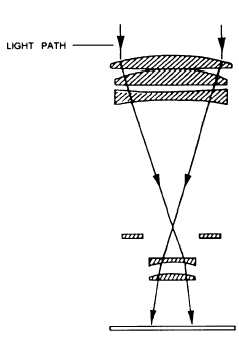front of the lens. When you use more than one filter or
a particularly thick filter, you may end up with
vignetting. This results in the edges of the image being
cut off, particularly at wide apertures. When using
wide-angle lenses, you should use lens hoods and filters
designed for the particular lens in question.
Ultra-Wide-Angle Lenses
Many ultra-wide-angle, or short-focal-length,
lenses are known as fisheye lenses. These lenses have a
focal length of less than about 17mm (for a 35mm
camera). The ultra-wide-angle view of these lenses
results in image distortion. Straight lines appear curved
and curved Lines may appear straight.
The use of fisheye lenses makes objects appear to
diminish in size rapidly as the distance from the camera
increases and objects which are close to the camera
appear far apart.
Depth of field with a fisheye lens is very great. ‘They
often give depth of field that extends from only inches
in front of the lens to infinity so that focusing is not
necessary.
Rectilinear Lenses
A rectilinear lens, despite its wide angle, has normal
rectilinear corrections so straight subject lines are
straight in the image and there is no obvious distortion.
The width of objects close to the camera appears
emphasized because of the steep perspective produced
by a rectilinear lens.
Macro Lenses
A macro lens is used for closeup photography and
is a valuable lens for any imaging facility to have. These
lenses come in various focal lengths and are capable of
producing up to one half or even life-size 1:1 images.
For example, a 100mm macro lens produces a 1:1 image
just as a 50mm macro does. With a 100mm lens, you do
not have to get as close to the subject. This is especially
useful when you are taking pictures of live creatures or
doing closeup medical photography.
Normal Focal-Length Lenses
The standard or normal focal-length lens for a
35mm SLR camera is from about 40mm to 58mm (the
most common being 50mm). This focal length gives a
field of view roughly the same as that over which the
eye gives satisfactory sharpness-thus the name normal
Figure 1-35.–Arrangement of lens elements in a telephoto lens.
focal length. With a normal lens, the angle of view and
the image size you see in the viewfinder are normal. That
is, you get much the same impression as you would get
if you look at the subject with one eye. Many Navy
photographers claim, however, that the wider angle of
view of a 35mm lens (for a 35mm camera) is preferable.
Others maintain that an 85mm focal length is better for
general use because it enables the picture space to be
filled more easily with subject matter.
A normal lens can be used for making pictures of
people if you do not get too close. When you fill the
frame with the face of the subject, you get image
distortion. It is better to stand farther back and include
the shoulders of the subject in the picture. This
eliminates distortion.
Telephoto Lenses
A lens with a focal length greater than about 58mm
for a 35mm camera is a long-focal-length lens. Most
modern, long-focal-length lenses are called telephoto
lenses because of their compact design. At one time,
long-focal-length lenses were essentially a lens at the
end of a long tube. A 500mm lens was spaced 500mm
from the film, and so on. However, by incorporating
other glass elements, the light passing through the lens
can be modified (fig. 1-35). This permits the lens barrel
to be physically shorter than the lens actual focal
length-an arrangement known as telephoto.
1-34



